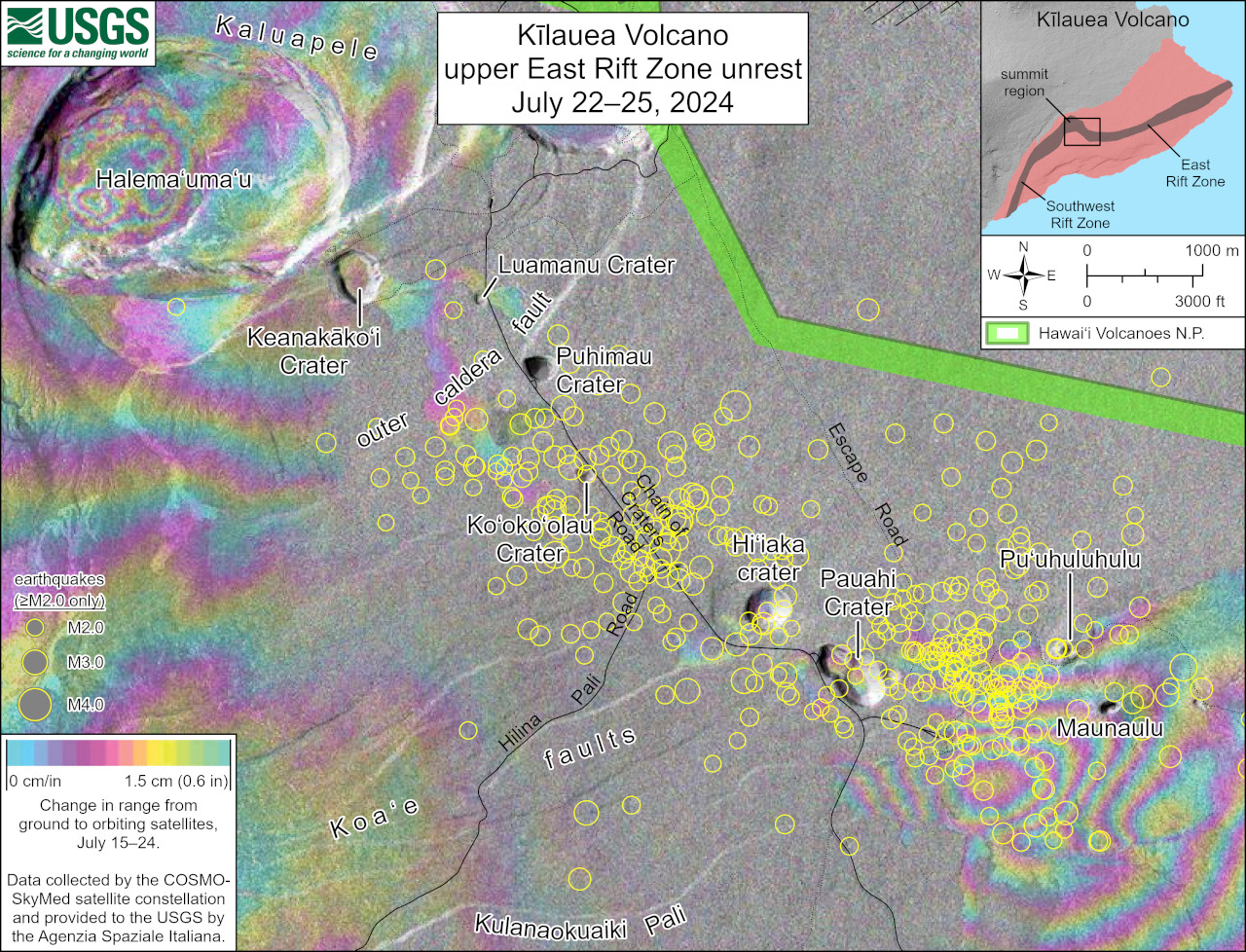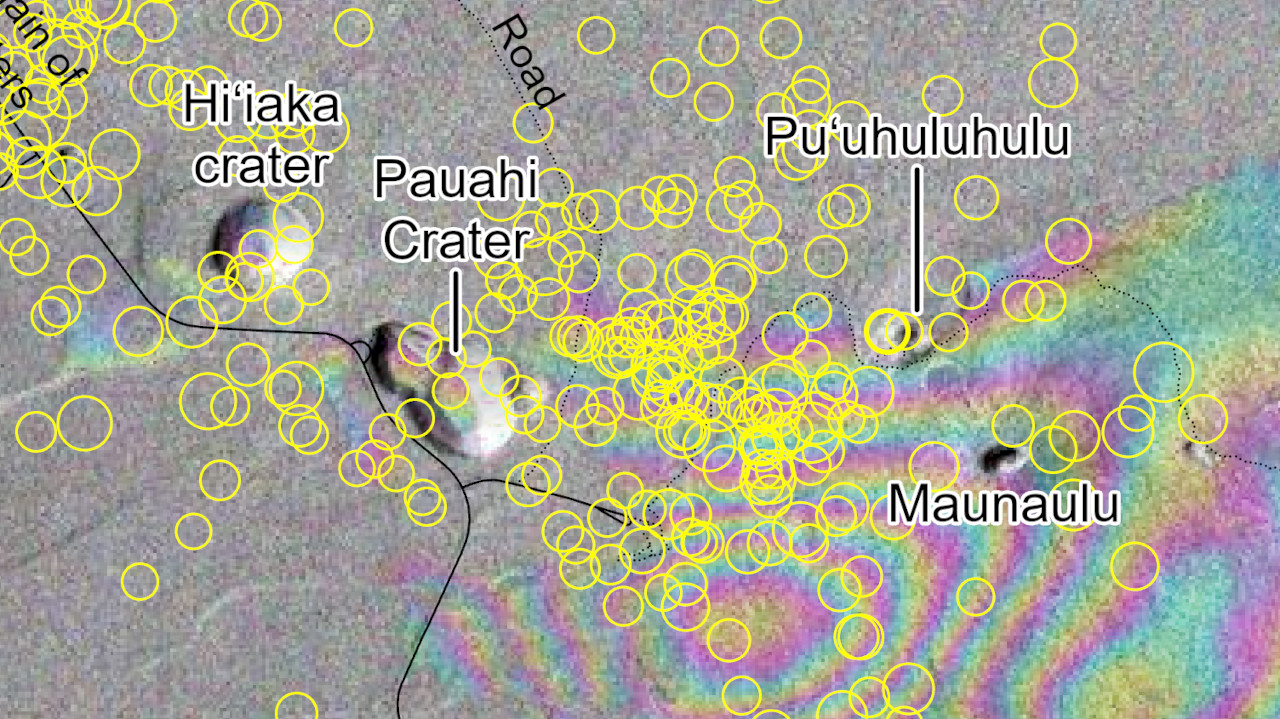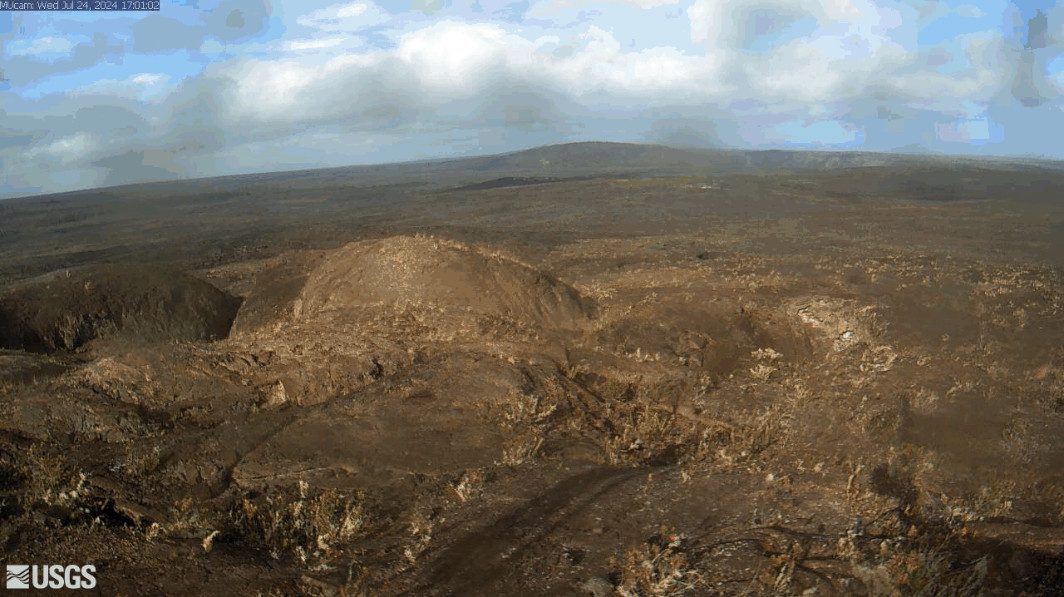(BIVN) – Kīlauea is not erupting, and its USGS Volcano Alert level is ADVISORY. Elevated unrest in Kīlauea’s upper East Rift Zone continued as of Thursday evening, as increased earthquake activity and ground deformation patterns indicate that an intrusion is ongoing in this area.
Closures within Hawaiʻi Volcanoes National Park remain in effect due to heightened seismic activity. Chain of Craters Road is closed at the Devastation intersection to the coast, Kulanaokuaiki Campground is closed, and Escape Road (trail) and Crater Rim Trail are closed south of Nāhuku.
The latest Volcano Watch article, written by U.S. Geological Survey Hawaiian Volcano Observatory scientists and affiliates, takes a closer look at what is going on beneath Kīlauea volcano.
From this week’s Volcano Watch:
The upper East Rift Zone (UERZ) of Kīlauea has been shaking more than normal, with nearly 1,500 earthquakes between July 22 and 25. The activity is being closely monitored by USGS Hawaiian Volcano Observatory (HVO) staff and prompted closures in Hawaiʻi Volcanoes National Park. What is causing it and what should we expect to see happen if it continues?
Kīlauea’s UERZ extends southeast of the summit to Maunaulu. Chain of Craters Road in Hawaiʻi Volcanoes National Park parallels the UERZ and is aptly named for the numerous craters that it passes by. These craters, as well as the nearby lava flows, tell us that the area has been volcanically active in the past.
Earthquakes began at a low rate in the UERZ within a few days after the June 3 eruption. Between June 27 and July 1, seismicity increased drastically with 1,500 earthquakes beneath the UERZ. That swarm was related to pressurization of the magma storage areas beneath Kīlauea’s summit, which were inflating following the June 3 eruption.
On July 22, another swarm of earthquakes began in Kīlauea’s UERZ and is ongoing. Earthquake locations have shifted, first being distributed along the UERZ, then concentrated near Pauahi Crater on July 23–24, and clustering to the northwest near Koʻoloʻolau Crater the morning of July 25.

USGS: “This reference map depicts recent unrest along Kīlauea’s upper East Rift Zone. Earthquakes that occurred between July 22–25, 2024, are shown as yellow circles. Recent ground deformation in this region, over the timeframe of July 15-24, 2024, is shown as colored fringes; data were recorded by the Italian Space Agency’s (ASI) Cosmo-SkyMED satellite. More fringes indicate more deformation, and each color cycle represents 1.5 cm (0.6 in) of ground motion. The bullseye feature southeast of Pauahi Crater on the upper East Rift Zone indicates inflation over this time period due to magma accumulation underground.”
Pulses of intense earthquake activity have been accompanied by changing patterns of ground motion, first in just the UERZ, then also in Kīlauea’s summit region. As earthquakes increased in the UERZ, Kīlauea’s summit began to deflate. This indicates that magma is moving from the summit storage regions into the UERZ, likely being intruded upwards into planar crack systems called dikes in the area between Pauahi Crater and Maunaulu.
This type of activity isn’t surprising for Kīlauea. During the past 50 years, there have been about 50 intrusive episodes like this in the UERZ. In each case, magma moved underground in the UERZ, causing earthquakes and ground deformation. Only five of the events resulted in UERZ eruptions: in 1968, May 1973, November 1973, 1974, and 1979. These eruptions were relatively brief, each lasting for hours to about a month.
The most recent significant intrusion in this area started on Father’s Day in 2007. An earthquake swarm near Maunaulu was accompanied by changing ground deformation rates. Over the following days, earthquakes moved downrift towards Puʻuʻōʻō in the middle portion of Kīlauea’s East Rift Zone. Cracks and steam vents formed, and a small amount of lava erupted in the middle East Rift Zone, downrift of Maunaulu.
Kīlauea’s UERZ also connects with the Koaʻe fault system, which is between Kīlauea’s Southwest and East Rift Zones south of the summit. It’s a complicated area—with deep cracks and vertical pali (cliffs)—that magma can sometimes move into, though eruptions have been rare. Deformation related to the ongoing swarm is localized along a strand of the Koaʻe fault zone, which is something that can occur when the fault zone is stressed.
These examples of past activity give us clues as to what could happen in the coming days and weeks. The UERZ intrusion could continue to grow underground, which has been the most common scenario in this area in the past.
The intrusion could result in a brief eruption in the UERZ, which has happened just a handful of times in the past 200 years.
The intrusion could also migrate to the east, farther down the East Rift Zone of Kīlauea, which in turn may or may not result in an eruption. If this occurs, HVO expects to see earthquake locations migrate to the east, past Maunaulu. Features on the middle East Rift Zone of Kīlauea, such as the lava shields of Maunaulu, Kāne Nui O Hamo, and Puʻuʻōʻō, are examples of long-lived eruptions in this area (months to years) but shorter duration eruptions are also possible.
Intrusions are common processes at active volcanoes, and at Kīlauea. Whereas lava flows on the surface are how shield volcanoes grow externally, they also grow internally via intrusions. The UERZ has not produced many intrusions in the near past, so this event is a unique opportunity to learn more about magma transport along the East Rift Zone. HVO will continue to closely monitor Kīlauea during this dynamic phase of UERZ activity.



by Big Island Video News4:58 pm
on at
STORY SUMMARY
HAWAIʻI VOLCANOES NATIONAL PARK - There have been over a thousand earthquakes in the upper East Rift Zone over the past few days. What could happen next?